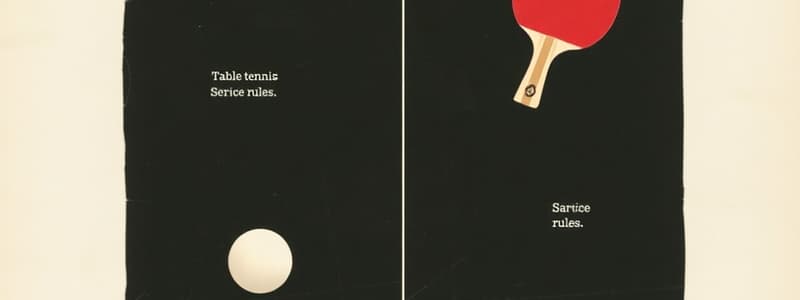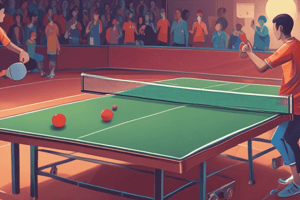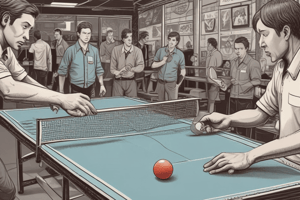Podcast
Questions and Answers
A match in table tennis can consist of the best of four games.
A match in table tennis can consist of the best of four games.
False (B)
The server must project the ball from a freehand above the playing surface for a valid service.
The server must project the ball from a freehand above the playing surface for a valid service.
True (A)
Players change ends after every point in a table tennis match.
Players change ends after every point in a table tennis match.
False (B)
A service must be thrown vertically at least 3 inches high to be considered legal.
A service must be thrown vertically at least 3 inches high to be considered legal.
If a serve touches the net but crosses over, the server gets to repeat the serve once more.
If a serve touches the net but crosses over, the server gets to repeat the serve once more.
A player receives a point if the ball touches their side of the court twice consecutively before the opponent plays it.
A player receives a point if the ball touches their side of the court twice consecutively before the opponent plays it.
In doubles, the ball can be served straight across the table without needing to touch the right side of the server's court first.
In doubles, the ball can be served straight across the table without needing to touch the right side of the server's court first.
A let ball is called if a served ball touches the net but is still a good serve.
A let ball is called if a served ball touches the net but is still a good serve.
A player loses a point if their free hand touches the playing surface while the ball is in play.
A player loses a point if their free hand touches the playing surface while the ball is in play.
During a service, if the server's free arm obstructs the receiver's view of the ball, it is considered a fault.
During a service, if the server's free arm obstructs the receiver's view of the ball, it is considered a fault.
Flashcards
Table Tennis Match Points
Table Tennis Match Points
A table tennis match is determined by 11 points, with a two-point margin needed to win. Each game is won by the first player to score 11 points, provided they are ahead by at least two points.
Serving in Table Tennis
Serving in Table Tennis
The server must project the ball from a free hand at least 6 inches above the playing surface and without spin, striking the ball on the server’s half, over the net, and into the receiver’s half.
Service Repeat (Table Tennis)
Service Repeat (Table Tennis)
If the ball touches the net during a serve and lands on the receiver's side, the serve is repeated. If it touches the net and remains on the server's side, the server loses that point.
Coin Toss in Table Tennis
Coin Toss in Table Tennis
Signup and view all the flashcards
Game Changeover Table Tennis
Game Changeover Table Tennis
Signup and view all the flashcards
Scoring in table tennis (point)
Scoring in table tennis (point)
Signup and view all the flashcards
"Let" in table tennis
"Let" in table tennis
Signup and view all the flashcards
Ball in Play (table tennis)
Ball in Play (table tennis)
Signup and view all the flashcards
Doubles serve rules (table tennis)
Doubles serve rules (table tennis)
Signup and view all the flashcards
Good Serve (table tennis)
Good Serve (table tennis)
Signup and view all the flashcards
Study Notes
Table Tennis Rules
- Match Format: Matches are best-of-two or three games. Games are played to 11 points.
- Winning a Game: The first player to 11 points, with a margin of 2 points, wins the game.
- Side Changes: Sides are changed after each game. In a three-game match, sides are changed again (and the first server from the previous game becomes the receiver) in the deciding game once a player reaches 10 points.
Service Rules
- Starting the Serve: Starting position of service player - The serving player can choose to serve from either side of the table. The player that wins the toss gets to select the side of the table to start the game and also to choose the first server and receiver.
- Height of Toss: The ball must be tossed at least 6 inches (15cm) above the playing surface.
- Server's Half: First the service ball has to touch the server's half first, cross over the net, and land in the receiver's half to be valid.
- Ball Contact and Net: If the ball touches the net, and crosses to the other side, the server has another serve (Repeat if necessary). If the ball touches the net and stays on the server’s side, it is a point for the receiver.
- Arm Position: The serving player's free arm must be out of the way before contact with the ball.
- Legal Serve: The service must not involve a spin; the ball must be projected from a freehand above the playing surface.
Points Awarded
- Faults: A server serving out of order or committing any fault leads to a point being awarded to the receiver.
- Poor Return: Failing to return a legal serve correctly or any match ball to the other half of the table means a point for the opponent.
- Contact with Playing Area: Any contact (accidentally or otherwise) of any body part(s), wearing apparel or the player's paddle with the playing surface whilst the ball is in play results in a point for the opponent.
- Contact with Net: Contact with the net during play is a point for the opponent.
- Wrong Side Return: Returning a ball that does not land on the designated recipient's side results in a point for the opponent, except during a service.
Lets (Restarting Play)
- Net Contact During Serve: If the server's service touches the net, and crosses the net, play restarts (let). If that service is returned unsuccessfully, it also restarts (let).
- Receiver Not Ready: If the receiver isn't ready when the service is made.
- Accident: If an accident occurs impacting service or return (e.g. accidentally moving the court)
Ball in Play
- Consecutive Touches: Touching the ball consecutively on your side of the table more than once gives the opponent a point.
- Un-hit Ball (passing over): If the ball touches both sides of the table, and is not hit, then it is a point to the opposite player.
Doubles Rules
- Diagonal Serve: In doubles, the service must be diagonal. The ball has to briefly hit the designated server's side of the court, before going over to the receiver's half.
- Serve Order (Doubles): The serve order follows a specific pattern (the order described in the original text) between partners.
Studying That Suits You
Use AI to generate personalized quizzes and flashcards to suit your learning preferences.




